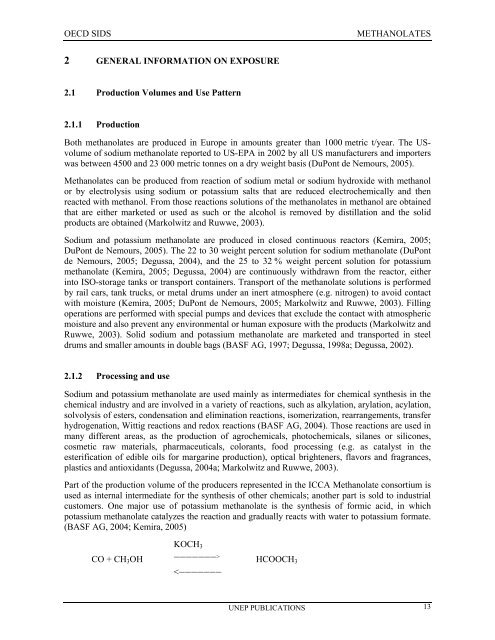Sodium methanolate - ipcs inchem
Sodium methanolate - ipcs inchem
Sodium methanolate - ipcs inchem
Create successful ePaper yourself
Turn your PDF publications into a flip-book with our unique Google optimized e-Paper software.
OECD SIDS<br />
METHANOLATES<br />
2 GENERAL INFORMATION ON EXPOSURE<br />
2.1 Production Volumes and Use Pattern<br />
2.1.1 Production<br />
Both <strong>methanolate</strong>s are produced in Europe in amounts greater than 1000 metric t/year. The USvolume<br />
of sodium <strong>methanolate</strong> reported to US-EPA in 2002 by all US manufacturers and importers<br />
was between 4500 and 23 000 metric tonnes on a dry weight basis (DuPont de Nemours, 2005).<br />
Methanolates can be produced from reaction of sodium metal or sodium hydroxide with methanol<br />
or by electrolysis using sodium or potassium salts that are reduced electrochemically and then<br />
reacted with methanol. From those reactions solutions of the <strong>methanolate</strong>s in methanol are obtained<br />
that are either marketed or used as such or the alcohol is removed by distillation and the solid<br />
products are obtained (Markolwitz and Ruwwe, 2003).<br />
<strong>Sodium</strong> and potassium <strong>methanolate</strong> are produced in closed continuous reactors (Kemira, 2005;<br />
DuPont de Nemours, 2005). The 22 to 30 weight percent solution for sodium <strong>methanolate</strong> (DuPont<br />
de Nemours, 2005; Degussa, 2004), and the 25 to 32 % weight percent solution for potassium<br />
<strong>methanolate</strong> (Kemira, 2005; Degussa, 2004) are continuously withdrawn from the reactor, either<br />
into ISO-storage tanks or transport containers. Transport of the <strong>methanolate</strong> solutions is performed<br />
by rail cars, tank trucks, or metal drums under an inert atmosphere (e.g. nitrogen) to avoid contact<br />
with moisture (Kemira, 2005; DuPont de Nemours, 2005; Markolwitz and Ruwwe, 2003). Filling<br />
operations are performed with special pumps and devices that exclude the contact with atmospheric<br />
moisture and also prevent any environmental or human exposure with the products (Markolwitz and<br />
Ruwwe, 2003). Solid sodium and potassium <strong>methanolate</strong> are marketed and transported in steel<br />
drums and smaller amounts in double bags (BASF AG, 1997; Degussa, 1998a; Degussa, 2002).<br />
2.1.2 Processing and use<br />
<strong>Sodium</strong> and potassium <strong>methanolate</strong> are used mainly as intermediates for chemical synthesis in the<br />
chemical industry and are involved in a variety of reactions, such as alkylation, arylation, acylation,<br />
solvolysis of esters, condensation and elimination reactions, isomerization, rearrangements, transfer<br />
hydrogenation, Wittig reactions and redox reactions (BASF AG, 2004). Those reactions are used in<br />
many different areas, as the production of agrochemicals, photochemicals, silanes or silicones,<br />
cosmetic raw materials, pharmaceuticals, colorants, food processing (e.g. as catalyst in the<br />
esterification of edible oils for margarine production), optical brighteners, flavors and fragrances,<br />
plastics and antioxidants (Degussa, 2004a; Markolwitz and Ruwwe, 2003).<br />
Part of the production volume of the producers represented in the ICCA Methanolate consortium is<br />
used as internal intermediate for the synthesis of other chemicals; another part is sold to industrial<br />
customers. One major use of potassium <strong>methanolate</strong> is the synthesis of formic acid, in which<br />
potassium <strong>methanolate</strong> catalyzes the reaction and gradually reacts with water to potassium formate.<br />
(BASF AG, 2004; Kemira, 2005)<br />
CO + CH 3 OH<br />
KOCH 3<br />
―――――――><br />
HCOOCH 3<br />
















